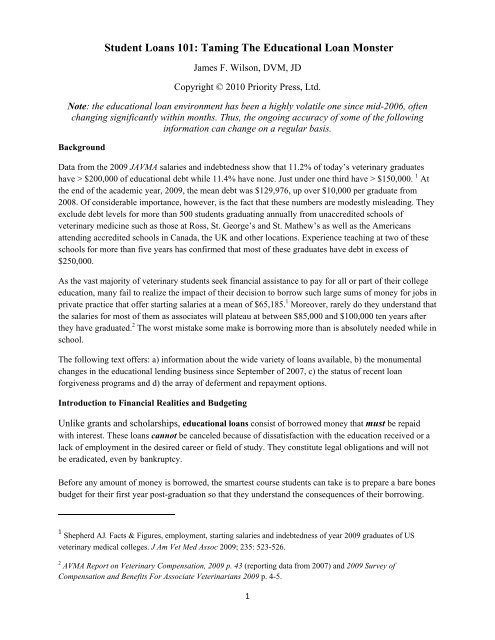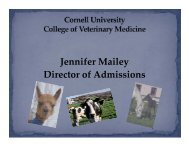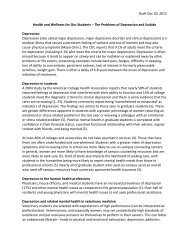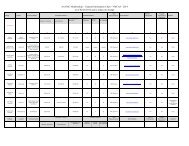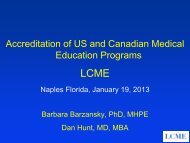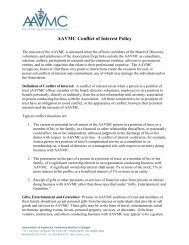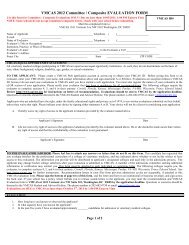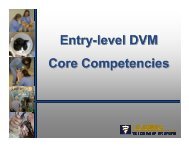Student Loans 101: Taming The Educational Loan Monster
Student Loans 101: Taming The Educational Loan Monster
Student Loans 101: Taming The Educational Loan Monster
You also want an ePaper? Increase the reach of your titles
YUMPU automatically turns print PDFs into web optimized ePapers that Google loves.
<strong>Student</strong> <strong><strong>Loan</strong>s</strong> <strong>101</strong>: <strong>Taming</strong> <strong>The</strong> <strong>Educational</strong> <strong>Loan</strong> <strong>Monster</strong>James F. Wilson, DVM, JDCopyright © 2010 Priority Press, Ltd.Note: the educational loan environment has been a highly volatile one since mid-2006, oftenchanging significantly within months. Thus, the ongoing accuracy of some of the followinginformation can change on a regular basis.BackgroundData from the 2009 JAVMA salaries and indebtedness show that 11.2% of today’s veterinary graduateshave > $200,000 of educational debt while 11.4% have none. Just under one third have > $150,000. 1 Atthe end of the academic year, 2009, the mean debt was $129,976, up over $10,000 per graduate from2008. Of considerable importance, however, is the fact that these numbers are modestly misleading. <strong>The</strong>yexclude debt levels for more than 500 students graduating annually from unaccredited schools ofveterinary medicine such as those at Ross, St. George’s and St. Mathew’s as well as the Americansattending accredited schools in Canada, the UK and other locations. Experience teaching at two of theseschools for more than five years has confirmed that most of these graduates have debt in excess of$250,000.As the vast majority of veterinary students seek financial assistance to pay for all or part of their collegeeducation, many fail to realize the impact of their decision to borrow such large sums of money for jobs inprivate practice that offer starting salaries at a mean of $65,185. 1 Moreover, rarely do they understand thatthe salaries for most of them as associates will plateau at between $85,000 and $100,000 ten years afterthey have graduated. 2 <strong>The</strong> worst mistake some make is borrowing more than is absolutely needed while inschool.<strong>The</strong> following text offers: a) information about the wide variety of loans available, b) the monumentalchanges in the educational lending business since September of 2007, c) the status of recent loanforgiveness programs and d) the array of deferment and repayment options.Introduction to Financial Realities and BudgetingUnlike grants and scholarships, educational loans consist of borrowed money that must be repaidwith interest. <strong>The</strong>se loans cannot be canceled because of dissatisfaction with the education received or alack of employment in the desired career or field of study. <strong>The</strong>y constitute legal obligations and will notbe eradicated, even by bankruptcy.Before any amount of money is borrowed, the smartest course students can take is to prepare a bare bonesbudget for their first year post-graduation so that they understand the consequences of their borrowing.1 Shepherd AJ. Facts & Figures, employment, starting salaries and indebtedness of year 2009 graduates of USveterinary medical colleges. J Am Vet Med Assoc 2009; 235: 523-526.2 AVMA Report on Veterinary Compensation, 2009 p. 43 (reporting data from 2007) and 2009 Survey ofCompensation and Benefits For Associate Veterinarians 2009 p. 4-5.1
Equally important, however, is the need to understand that over half of the associate veterinarians in theU.S.A. will have their salaries linked to their revenue production. 3 Thus, they also need to understandveterinary medicine as a business and not just as a “calling.”Since the interest rate on federal Direct <strong><strong>Loan</strong>s</strong> has been fixed at 6.8% since July 1, 2006 the only way tounderstand the financial effects of their investment in their veterinary degree is to calculate the total costof repaying their debt at different terms of years and, then, add that to their expected costs of living,FICA, Medicare and income taxes.<strong>The</strong> best source of assistance for this is to use the financial simulator salary projection and personalbudget program located on the Veterinary Pet Insurance Co. sponsored www.finsim.umn.edu website. 4<strong>The</strong> hope is that as students do this, they will have a clearer understanding of the true effect of the moneythey are borrowing. Lastly, they must then relate all of this financial information to their potentialgeneration of income so they can see what will be required to balance their budgets and save for thefuture after graduation.Any education at the collegiate level must be considered a long term investment. However, because theveterinary degree adds four more years and, for nearly half of today’s graduates, a $28,545 internship 1 tothe cost of this educational degree, matching the right educational loans and debt level to the potentialcareer income is crucial to investing this borrowed money wisely. For example, if the only way forstudents to complete the necessary education and training to become a veterinarian is to borrow $250,000or more 5 , and they are unwilling to work 40 plus hours per week for more than 25 years, then a career inveterinary medicine most likely will not provide them with a good enough ROI (return on investment) fortheir loans to be considered a smart use of the money they are borrowing. Even those borrowing thenational average of $130,000 in 2009 will be paying $902 per month in principal and interest for twentyfive years post graduation. This is more than the vast majority of students are paying in rent whileattending veterinary school.Understanding the Types of <strong>Educational</strong> <strong><strong>Loan</strong>s</strong>, Sources of Money and the Key TermsMuch of the information that follows is available on web pages at www.studentaid.ed.gov and/orwww.finaid.org.1. Direct Stafford <strong><strong>Loan</strong>s</strong>. <strong>The</strong>se are direct loans that come from and are repaid directly by theborrower to the federal government. All AVMA accredited schools and Ross University provideaccess for their students to the Direct <strong>Loan</strong> Program. St. George’s and St. Mathews Universitiesin the Caribbean are working diligently to allow their students access to these loans even though3 Information acquired from NCVEI, 2009.4 Updated annually, this calculator was developed by David Lee, DVM, MBA, Hospital Director at the University ofMinnesota in collaboration with JF Wilson, DVM, JD and funded by Veterinary Pet Insurance.5 Author’s note: A $250,000 educational loan at the current 6.8% interest rate payable over the longest repaymentterm currently available, i.e., twenty-five years, results in payments of $1,735 per month.2
as of 2010 they are still unaccredited. In general these loans are available to all undergraduate,graduate, and accelerated or continuing education students.a. Subsidized Stafford <strong><strong>Loan</strong>s</strong> are available only to students who have financial need. <strong>The</strong>federal government pays the interest while the student is in school and/or an internship orresidency in a post-secondary educational institution and during what is called the graceperiod. Grace periods consist of the time between graduation and a date when repayment ofall federally subsidized loans starts. This is usually six months after graduation. <strong>The</strong> annuallimit for these loans is $8,500 per year for graduate students.b. Unsubsidized Stafford <strong><strong>Loan</strong>s</strong> are available to all students, regardless of financial need.However, unless the interest on this loan is paid while students are in school, it cumulates andis added to the loan amount when payments start. <strong>The</strong> annual limit here is $32,000.(http://www.finaid.org/loans/studentloan.phtml)2. Federal Family Education <strong><strong>Loan</strong>s</strong> (FFEL). Historically, these were student loans made byprivate lenders (usually banks) that provided funds and for which students made loan repaymentsdirectly to the banks. As with Direct <strong><strong>Loan</strong>s</strong>, the federal government and guaranteed therepayment of these. FFEL loans consisting of the following: a) Stafford <strong><strong>Loan</strong>s</strong> described above asDirect loans, b) FFEL PLUS <strong><strong>Loan</strong>s</strong>, and c) FFEL Consolidation <strong><strong>Loan</strong>s</strong>. Prior to 2008, vigorouscompetition forced banks to offer FFEL loans with various types of incentives. In the heyday ofthe loan consolidation period from 2004 to 2006, these programs included reductions of 0.25% inthe interest rate for direct withdrawals from checking accounts and up to another 1% after 36consecutive on time payments. With added subsidies from state governments some studentsended up with interest rates of less than 1.5%. However, if borrowers had a month withinsufficient funds to make a payment, in many cases this reduction was lost forever.As a result of 2006 regulatory changes in educational loans made by the U.S. Congress, in 2007,the private bank FFEL lenders were pretty much knocked out of the lending business. In fact, asof the summer of 2010, it appears that these types of loans may disappear entirely, to be replacedonly with Director or private loans. (Again, visit www.finaid.com for the most up-to-dateinformation.)3. Graduate PLUS <strong><strong>Loan</strong>s</strong> (Direct and FFEL). <strong>The</strong>se loans are only available to graduate studentsand are supplemental to the $40,500 available annually via Stafford <strong><strong>Loan</strong>s</strong>. Because they arehigher risk loans, the interest rate on these loans is higher than Stafford <strong><strong>Loan</strong>s</strong>, i.e., 7.9% forDirect Grad PLUS loans. After borrowing the maximum allowed through the Stafford <strong>Loan</strong>program, students may borrow up to the cost of annual graduate school attendance via theseloans. <strong>Student</strong>s attending state schools as non-residents and/or the private schools are those mostoften using these loans. <strong>The</strong> university determines the amount needed to fulfill the cost ofattendance.4. Health Professions <strong>Student</strong> <strong><strong>Loan</strong>s</strong> (HPSL). <strong>The</strong>se, too, are need-based, long-term, low-interest(5% five percent) loans provided by the U.S. Department of Health and Human Services forhealth professional schools, including veterinary schools. If these loans are available at thestudent’s school, the financial aid office will determine the eligibility. As with subsidizedStafford loans, the interest is paid by the government while borrowers are enrolled in schools,during internships and residencies and over a one year grace period.3
5. Perkins <strong><strong>Loan</strong>s</strong>. <strong>The</strong>se loans are offered by schools to students who have the greatest financialneed. Perkins loans come from the schools that students attend and, thus, are repaid to the schoolitself. Perkins loans are low interest (5%) and have no additional fees or charges unless borrowersdefault on their payments. As with subsidized Stafford loans, the interest is paid by thegovernment while the borrower is enrolled in school, during internships and residencies and overa nine-month grace period.6. Private <strong><strong>Loan</strong>s</strong>. <strong>The</strong>se are educational loans from banks and/or other financial institutions thatlend money to students who are in non-AVMA accredited schools or who are non-residents andunable to obtain any, or enough, money from the above loan sources. Because of the creditcrunch following the crash of real estate loans in the fall of 2008 and the fact that these loans arenot guaranteed by the federal government, they bring with them a higher risk of default. <strong>The</strong>yusually come with loan origination fees, some of which could be as high as 8% of the loanbalance and much higher interest rates than Direct and Grad Plus <strong><strong>Loan</strong>s</strong>. Occasionally, studentsmistakenly use private loans before exhausting all available federal loans. This can be costly.Private student loans can be a helpful source of funds when federal loans are not available (e.g.,during internships or for emergency or relocation expenses). However borrowers must understandthe effect of the high interest rates and costs of acquiring such loans.Interest rates for private loans in 2010 generally are at the LIBOR (London Interbank OvernightRate) plus 10%, depending on the month of the year, and one’s credit scores – as determined bythe bank. In 2010, the average private loan interest rate is between 11% and 16%, cumulatinginterest while students are in school and this during a time of extremely low interest rates. Sinceprivate loans almost always have variable interest rates, these loans will likely have much higherrates in the future when the underlying rates (Prime or LIBOR) trend back to the average. <strong>The</strong>turmoil in the credit markets has caused lenders to increase the margins (prices) on loans as wellas the credit standards. <strong>The</strong> results are higher-priced private student loans that are more difficultto obtain.WAYS TO OBTAIN MONEY THAT DOESN’T NEED TO BE REPAIDWhile almost all students can qualify for loans, some can acquire money that does not need to be repaid.<strong>The</strong> most common forms for this come from grants and scholarships. Some schools also offerachievement awards, commuter discounts, as well as work study programs to ease the financial burdenfacing their students.1. Pell Grants. Unlike loans, Pell Grants do not need to be repaid and are usually provided only toundergraduate students who have documented severe economic needs. <strong>The</strong>se grants are availableto undergraduate and graduate students but not to accelerated or continuing education students.2. Scholarships. In addition to a multitude of athletic scholarships that provide a full ride forathletes in exchange for their athletic performances, millions of dollars in scholarship money areawarded for other reasons. This includes everything from academic performance to simply beingleft handed. If you don’t mind writing essay after essay, there likely is a scholarship that is rightfor you. For more information about potential scholarships log onto www.scholarships.com orcontact your university’s financial aid office.4
3. Tuition Reimbursement. In an effort to improve the value and knowledge of their employees,some employers offer tuition reimbursement benefits to employees interested in continuing orfinishing their education.Benefits can range from partial to full reimbursement with limited to no commitment from theemployee to stay employed by the company. <strong>The</strong>se are tax deductible for the employer and resultin tax-free income for employees. <strong>The</strong>y are called §529 Qualified Tuition Programs (QTPs) or§529 Plans. If you are employed even part-time at a veterinary practice at which you are likely toseek work after graduation, ask your employer about this option. Of course if you are a 3 rd or 4 thyear vet student, there will be not time during which you could work.4. Federal Relief. <strong>The</strong> federal government has recognized the need to relieve the educational debtsfor employees working in the field of education. Thus, it is creating loan repayment incentives forstudents entering this arena.5. Work Study. Most universities offer work study programs where students can work for theschool or organization in exchange for discounted tuition, paid tuition, class credit, or otherbenefits. Work study differs from reimbursement because the money goes directly to theuniversity strictly for tuition. Most jobs are only available through the schools that studentsattend.WHO’S IN CHARGE OF REGULATING FINANCIAL AID?In general, the U. S. Government regulates the majority of the educational loan market for collegestudents through federal legislation that sets interest rates and allows for funding directly by the federalgovernment (Direct <strong><strong>Loan</strong>s</strong>) or, in prior years, by private banks through the FFEL approach such as byBank of America, JPMorgan Chase, Sallie Mae, Wachovia (now owned by Wells Fargo) and many more.<strong><strong>Loan</strong>s</strong> that were derived through the banking industry had been funded via an infusion of money primarilyfrom private investors in the form of notes known as securities. <strong>The</strong> banks then formed lendingrelationships with students who received loan payments directly from them (FFEL loans).Up until 2007, banks were able to receive an attractive return on their investments in the student loanbusiness. Though profit margins may not have been as high as in other investment sectors, studentsgenerally paid back their loans, and if they defaulted, the government backed the loans. As of 2010, itappears that this educational loan funding system for students is no longer a factor in the market.WHAT PUSHED BANKS OUT OF THE MARKET?Two key factors contributed to the spring 2008 exit of over 55 lenders who made up 13% of the totalstudent loan market (www.money.cnn.com, April 2008).1. As part of the federal legislation signed by President Bush in September of 2007, banks beganreceiving lower subsidies from the federal government in the form of a lower interest rate marginwith which to work. Historically, the interest rate for the federally-backed FFEL loans was set atthe 90-Day Treasury Bill rate plus 2.34%. This gave banks a reasonable margin with which towork and still make money on their educational loan portfolios. However, as part of this 2007legislation, Congress lowered the subsidy for these loans to the T-bill rate plus 1.79% for loansoriginating after July 1, 2007. This 0.55% reduction in the subsidy lowered the margins for thebanks. Coupled with the second major change in the financial sector, i.e., higher funding costs as5
a result of the subprime real estate mortgage debacle, it became clear that bank lenders could nolonger generate any profits from this line of business (www.money.cnn.com, April 2008). In fact,many who considered staying in the business found that they would lose money on eacheducational loan they made.2. <strong>The</strong> 2007-2009 credit crunch that hit Wall Street. Changes in the real estate mortgage market thatstarted in 2007 caused interest rates to go up as a result of the reduced amount of availablecapital. Millions of borrowers with adjustable rate mortgages (ARMS) saw their variable rateinterest loans rise by as much as several percentage points. This has brought about the default inpayments on such loans by up to 2% of homeowners across the USA, much higher than that insome hard hit regions of the U.S.A. As a result of this change in the market, large financialinstitutions such as Citigroup, Merrill Lynch, Lehman Bros., Countrywide Financial, and Bank ofAmerica lost hundreds of billions of dollars. One of the five biggest, Bear Stearns, was savedfrom bankruptcy in the fall of 2008 only by action of the Federal Reserve Banking System and abuyout by JP Morgan Chase. Lehman Brothers had already gone bankrupt in the spring of 2008.To avoid a bank failure, Wachovia was purchased in the fall of 2008 by Wells Fargo, one of thewiser banks that had not been devastated by the subprime mortgage mess.<strong>The</strong> result has been private investors demanding higher interest rates for their securities.Historically, this has been the source of the money lenders have used for their educational loans.This resulted in less (or in many cases no) money available for educational loans in 2008; and,when coupled with a slowing economy and higher risks of default by debt burdened recentgraduates, the educational loan industry was thrown into a spring 2008 turmoil(www.bloomberg.com).<strong>The</strong> bottom line: lower subsidies from the government and increased borrowing costs for banks in theeducational lending industry made the federally guaranteed student loan market an unprofitable venturefor the banks that previously served as a major source of funds for student loans.THE FUTURE OF STUDENT LENDING AND EDUCATIONAL DEBTGovernment In May of 2008, the Federal government passed a bill (H.R. 5715) allowing the U.S.Department of Education to buy the remaining 2007-08 federally guaranteed loans that had not beenpurchased by private banks. Without government intervention, it was expected that demand for loans tofulfill the needs of students headed to school in the fall of 2008 would have vastly exceeded supply. This,in turn, would have prevented many students from attending school and many universities from balancingtheir budgets. A June 11, 2008, report estimated that students would be borrowing about $93 billion fortheir 2008-2009 academic year, $70 billion of which would come from federally guaranteed loans(www.bloomberg.com).LOAN CONSOLIDATION – MAJOR CHANGES IN RECENT YEARS1. Prior to July 1, 2006, Stafford loans were variable rate loans that changed each July 1 st asadjusted by the rate on the 90-Day Treasury Bill. <strong>The</strong> Federal Consolidation <strong>Loan</strong> Programallowed students to lock-in these variable rate loans, which is why consolidation became popularduring the period of low interest rates commencing in the early 2000s. A regulatory changeannounced in 2005 adjusted Stafford <strong>Loan</strong> interest rates to a fixed rate of 6.8% for all newgraduate student loans disbursed after July 1, 2006. This interest rate has remained fixed at 6.8%6
for graduate students since that time. <strong>The</strong> interest rate for undergraduate loans gradually dropsto 3.4% by 2011 (on subsidized Stafford only). More information, including updated rates, canbe found at www.studentaid.ed.gov.2. Prior to the 2006 legislation on this subject, students could consolidate their loans while inschool. Even better, as interest rates dropped, they could consolidate (i.e. fixing the interest ratedownward) more than once. This was big business for all of the bank lenders from 2003 to 2006.During that time students were consolidating their loans at less than 3% and in some cases withthe aid of various incentives, achieving interest rates as low as 1.2%. Unfortunately, those daysare long gone for today’s students.DEFERMENTS AND FORBEARANCEUpon graduation, loans typically have a six-month Grace Period during which students do not have tomake any payments. After this grace period there are two different ways to delay payment, each of whichwill generate even more interest in most cases! Graduates who feel they will be unable to make theirmonthly payments should not waste any time before contacting their loan providers. Fees andpenalties are high for missing payments and will adversely affect credit scores. That, in turn, leads tohigher interest rates for credit card and other debts incurred for costs of living or auto loans.If you are concerned about making payments or would like assistance in determining the best strategy,Graduate Leverage’s Advisory Service is a great resource to ensure you are well informed and aremaking the best decisions regarding your debt or any of the options described below. For moreinformation and a personalized assessment of how they may be able to assist you can go towww.glAdvisor.com.<strong>The</strong> section below outlines options available for postponing loan payments on Federal loans.1. Deferments. This is a temporary suspension of loan payments where interest does not accrue tothe borrower on subsidized loans but does on unsubsidized ones. Graduates must meet certainqualifications to receive a deferment. <strong>The</strong> most common qualifications for federal loans are listedbelow. <strong>The</strong> entire list can be found athttps://www.dl.ed.gov/borrower/QctrHelpIndex.do?SectionId=FAQU&APageID=QctrFaquA011.a. In-school deferments are for students who are enrolled in school at least half time andfulfill the qualifications for this valuable aid.b. Education related deferments are for students with these types of loans who are seekingpost-graduate training at institutions of higher education or at other named institutions ororganizations during their graduate fellowships, internships, and residencies. This isalmost always limited to situations where students are obtaining another or an advanceddegree, yet still considered a student.Interest is deferred on subsidized loans but cumulates on unsubsidized ones, althoughborrowers have the option of paying the unsubsidized interest as they go – if they can.c. Economic hardship deferments (EHD). Historically, borrowers qualify for this type ofdeferment for up to three years post-graduation and qualification is based on a number offactors. Many borrowers who qualified for EHD in the past did so through a debt to7
income type ratio, however, this type of qualification changed on July 1 st 2009. Goingforward, income alone will determine qualification for most applicants. Financial datamust be provided to the lender or servicer each year to retain this EHD and therecurrently is a three year limit. This type of deferment often was used by students whowere in private practice internships or residencies. Similar to the above types ofdeferments, borrowers will not accrue interest on subsidized loans but will on allunsubsidized loans, adding to the loan balance to be repaid once payments start again.<strong>The</strong> change in qualification requirements for EHD makes it much more difficult toqualify and, in fact, as of 2010, this option has nearly been replaced by the income basedrepayment (IBR) system discussed subsequently.d. Unemployment deferments. Borrowers who are unable to find employment may qualifyfor deferments for up to three years. Again, interest cumulates on all unsubsidized loansduring this period and is added to the principle.e. Military deferments. <strong>The</strong>se have been created for those who pursue military service. Formore information on this option visit www.studentaid.ed.gov.2. Forbearance. This is a temporary suspension of loan payments where interest accrues on bothsubsidized and unsubsidized loans. Graduates do not need to meet any qualifications to begranted forbearance, and may reapply for up to five years in some cases. As expected, the loanbalance will rise substantially but this may give new graduates time to grow into their career,earning a much higher salary than during their first year after graduation.LOAN REPAYMENT OPTIONSWhen considering loan repayment, there are several options and plans from which to choose. And, chooseyou must, unless you plan to pay off the loans within a ten year period. If a repayment period orextension is not specified, the plan will automatically be set and billed at the 10-year Standard RepaymentPlan. <strong>The</strong> list below is specific to Direct Stafford loans. For more detailed information on all of theseoptions, visit www.studentaid.ed.gov and www.loanconsolidation.ed.gov on a regular basis.Whereas most of the repayment options apply to all students who have Federal Direct <strong><strong>Loan</strong>s</strong>, the first ofthis group has a long history and is unique to veterinary medicine.1. Veterinary Medicine <strong>Loan</strong> Repayment Program (VMLRP). In the spring of 2010, the USDANational Institute of Food and Agriculture (NIFA) announced the next phase of the VeterinaryMedicine <strong>Loan</strong> Repayment Program (VMLRP). It is designed to identify and communicate thedesignated shortage areas (undeserved areas selected by the USDA from the applications receivedby the State Animal Health officials) and to promote requests for applicants. Thanks to persistentlobbying by the AVMA, this program, first passed by Congress in 2003, will finally beimplemented in 2010.<strong>The</strong> VMLRP will assist veterinarians selected for the program with repayment of theireducational debt. To date, Congress has provided a total of $9.6 million for the program,including $4.8 million in the fiscal year 2010 agriculture appropriations bill, signed by PresidentObama in October2009.8
Information about the program, the designated shortage areas, and the application forms can befound at www.nifa.usda.gov/nea/animals/in_focus/an_health_if_vmlrp.html. Based on a May2010 PVMA newsletter, Pennsylvania has two shortage areas. In both of these designated areasthere is a shortage of private practice veterinarians who serve beef and dairy cattle, swine,poultry, and small ruminants.<strong>The</strong> VMLRP will allow participants to retire up to $25,000 per year of qualified educational debtincurred at accredited U.S. colleges of veterinary medicine. In addition, at least for 2010recipients, the National Institute for Food and Agriculture, NIFA, (formerly titled the CooperativeState Research, Education, and Extension Service) will reimburse participants for the tax liabilitythey would have incurred as a result of this loan forgiveness program which, depending on theirtax bracket, could be up to 39% of the total amount of the loan forgiveness in a calendar year.Without this supplemental funding that money would have created heavily burdensome taxableincome for recipients.Eligible applicants must have a veterinary degree, or the equivalent, from a school accredited bythe AVMA, have qualifying educational loan debt, be offered employment, establish or maintaina practice in a veterinary shortage area, and spend 80% of their time as food animal veterinarypractitioners. <strong>The</strong>y also must stay in the designated area for three to four years. Because fundingis limited, not all veterinarians applying to the VMLRP are expected to receive loan repaymentawards.Interested parties can follow further action at http://www.avma.org/advocacy/default.asp. It isexpected that NIFA will select the first cohort of veterinarians to fill these slots by Fall 2010.Anyone who wishes to receive news on this subject as it is published in the AVMA Advocateshould contact Eric McKeeby at emckeeby@avma.org and asked to be placed on the mailing list.2. State <strong>Loan</strong> Forgiveness Plans. As a result of recent state VMA legislative lobbying, manystates now have their own loan forgiveness plans, especially for veterinarians serving the ruraland food animal sectors of the industry. For more information on these options visitwww.avma.org/advocacy/state/loan_repayment_programs/default.asp.3. Standard Repayment Plan. This entails monthly payments at a fixed amount for up to ten years.<strong>The</strong>re is a $50 minimum monthly payment.4. Extended Repayment Plan. This is similar to standard repayment but calculates a loan termbetween 12 and 25 years based on the total amount borrowed and the type of loan. Keep in mindthat although a longer repayment period may create smaller payments, it also increases the totalamount of money that must be repaid due to the accrued interest. A balance of $30,000 or more intotal student loan debt is required for the twenty five-year extended plan. In all cases grads canpay down the loan more quickly at any time.5. Graduated Repayment Plan. Like the extended plan, the loan term is between 12 and 25 years.Unlike the standard and extended plans, the graduated plan starts off with lower payments whichincrease every two years. <strong>The</strong>re is a $25 per month payment minimum, and the monthly paymentat any time must be greater than 50% and less than 150% of what the monthly payment would beunder the standard repayment plan.9
6. Income Contingent Repayment (ICR). Monthly payments are based on the borrower’s annualincome, Direct <strong>Loan</strong> balance and family size, with fixed interest and repayment periods of up to25 years. After 25 years, any remaining unpaid debt will be forgiven and treated as one-timetaxable income that year. Additionally, the ICR includes an interest capitalization cap.ICR only applies to loans made by the U.S. Department of Education, not those in the pre-2006FFEL Program. However, FFEL loans may be consolidated into federal direct consolidationloans, which then may be ICR eligible. 67. Income Sensitive Repayment (ISR). This plan pertains only to older FFELP loans. <strong>The</strong>maximum repayment period is equal to the standard ten-year period, and payments are based onannual income alone and range from 4% to 25%. Lenders providing this option are concernedwith the debt to income ratio of the borrower in order to ensure that the monthly payment ishigher than the interest accrued during that period. Borrowers must apply yearly for this option.8. Income Based Repayment (IBR). This is a new type of payment relief starting July 1, 2009. Itprovides a middle ground between Economic Hardship Deferment and Standard RepaymentTerms. Intended to help graduates with lower salaries, many veterinary students with a highdebt-to-income ratio stand to gain substantial support from this plan when compared to otherprofessional graduates. <strong>The</strong> plan includes a) an alterable, 25-year repayment period, b) monthlypayments based on family size and yearly income, capped at 15% of the borrower’s discretionaryincome, c) partial subsidies for interest on Stafford Subsidized loans (for up to three years) and d)loan forgiveness for balances remaining after 25 years of repayment.To determine discretionary income, loan servicers will use the bottom line on the first page of ataxpayer’s Form 1040 tax return. This establishes what the IRS terms as the taxpayer’s AdjustedGross Income (AGI). This important figure also is the basis for tax deductions elsewhere in thetax return. In the future, servicers and/or lenders will obtain this information directly from theIRS for calculations associated with this program. Participants’ AGIs will be used to determinetheir qualification and to calculate each succeeding year’s monthly payments under this program.As of 2010, the amount of each person’s loan that is forgiven at the end of the twenty five-yearIBR period will become taxable income in that year. For graduates with large debts remaining atthat time, this will be a serious tax burden for which excellent financial planning will be essential.Further details regarding forgiveness, the debt-to-credit ratio and joint vs. individual incomerules are available at www.finaid.org. Overall, income-based repayment (IBR) is probably betterfor borrowers than income-contingent repayment (ICR), especially as the borrower’s financialcircumstances improve. (See www.finaid.org for more information on this and the Public Service<strong>Loan</strong> Forgiveness program that provides loan forgiveness after ten years of public service. Publicservice jobs include, among other positions, government and military service plus many others,including work for tax exempt §501c(3) organizations.6 If the direct consolidation loan people say that you must have defaulted on your FFEL loans to consolidate into direct loans,remind them that this restriction was repealed by sections 7015(c) and 7015(d) of Public Law 109‐234, the EmergencySupplemental Appropriations Act for Defense, the Global War on Terror, and Hurricane Recovery, June 15, 2006. If they stillgive you trouble, ask the FSA Ombudsman for help.10
As mentioned previously, the Graduate Leverage firm has spent considerable time developing aloan repayment analysis system that helps fourth year students, interns, residents and recent gradsdetermine how and whether IBR repayment plans can assist them as they select from among thesesix repayment options.See Also – Separate Document EntitledNewest Changes Coming in Federal <strong>Loan</strong> Repayment Programs (July 2010)SUMMARY AND WHERE TO GO FROM HEREThis is a condensed explanation of the recent crisis in the rapidly changing educational loan world. It istruly wreaking havoc on all veterinary students with loans equal to or higher than the 2009 nationalaverage of $130,000. It is not a pretty picture, and because of the skyrocketing national debt, no easygovernmental solutions are in sight.However, as discussed previously, many options exist for students or new grads who want to do theirhomework to reduce their debt and total payback of interest and principal - and more options arebecoming available. Graduate Leverage (GL) provides a valuable debt advisory service and the analyticaltools to graduate level college students who often will not find time in their schedules to pick the bestcourse for repayment as they migrate through this minefield of options. Obtaining correct andcontemporary information requires a great deal of due diligence and planning in order to make decisionsabout this expensive, complex, confusing and ever-changing financial issue. A more thorough descriptionof Graduate Leverage’s service can be found at www.glAdvisor.com.Many thanks to Gina Luke, AVMA GRD, Tori Long, VMRVMC class of 2012, VBMA student extern atPVMC, Mike Wilson, Chestnut Hill College class of 2009, Matthew Turner, NCSU class of 2011,Nathanael Oster, U of Penn class of 2012 and Fritz Wood, CPA, CFP who spent many hours locating thematerial for and editing the multiple drafts of this information to help students in veterinary schoolsacross America! <strong>The</strong> newest contributor to the accuracy of this information is Gina Luke at the AVMAGovernment Relations Division. <strong>The</strong> most thanks, however, are in order for the effort provided by ToddBalsley, MBA, Executive Vice President of Graduate Leverage without whom the accuracy of thisdocument always would have been in question.11


